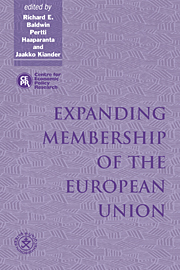Book contents
- Frontmatter
- Contents
- List of figures
- List of tables
- Preface
- Acknowledgements
- List of conference participants
- 1 Introduction
- PART ONE THEORETICAL ISSUES
- PART TWO POLICY ISSUES
- 5 Voting power and control in the EU: the impact of the EFTA entrants
- 6 Migration in the integrated EU
- 7 Trade effects of regional aid
- PART THREE EMPIRICAL ISSUES
- Index
5 - Voting power and control in the EU: the impact of the EFTA entrants
Published online by Cambridge University Press: 05 November 2011
- Frontmatter
- Contents
- List of figures
- List of tables
- Preface
- Acknowledgements
- List of conference participants
- 1 Introduction
- PART ONE THEORETICAL ISSUES
- PART TWO POLICY ISSUES
- 5 Voting power and control in the EU: the impact of the EFTA entrants
- 6 Migration in the integrated EU
- 7 Trade effects of regional aid
- PART THREE EMPIRICAL ISSUES
- Index
Summary
Introduction
National aspects and the balance of national voting power in the EU play an important role as long as the governments have direct influence in the decision making process. The decisive body of the Union is the Council of Ministers where Germany, Italy, France and the UK have 10 votes each; Spain 8 votes; the Netherlands, Greece, Portugal and Belgium 5 votes each; Denmark and Ireland 3 votes each and Luxembourg 2 votes. Decisions are made mainly by the qualified majority for which 54 votes out of 76 were required before the EFTA countries' entry. Among the new entrant countries, Austria and Sweden have 4 votes and Finland has 3 votes. The qualified majority in an expanded EU is made up of 62 votes out of 87.
The Council of Ministers offers a nice example for cooperative game theory, since it is a weighted majority game with an asymmetric decision making rule. Since 1986, when the Single European Act came into force, the role of qualified majority voting has become more important. Recently there have been pressures towards simple majority or so-called double majority voting in the Council, due to the fear of Union's weakening abilities to operate after the enlargement.
The purpose of this chapter is to analyse national influence in the EU. The concept of ‘influence’ is divided into direct effect on outcomes of votings and to control (see section 2).
- Type
- Chapter
- Information
- Expanding Membership of the European Union , pp. 113 - 142Publisher: Cambridge University PressPrint publication year: 1995
- 4
- Cited by



